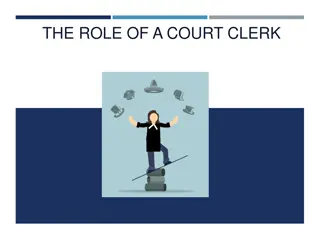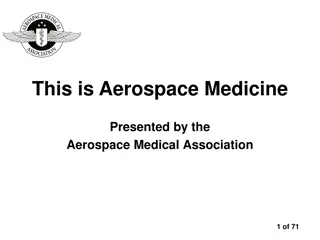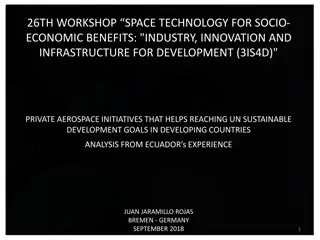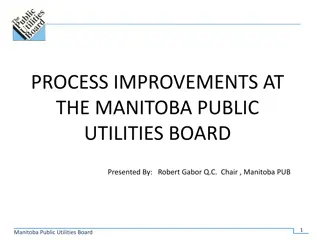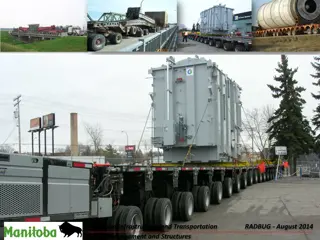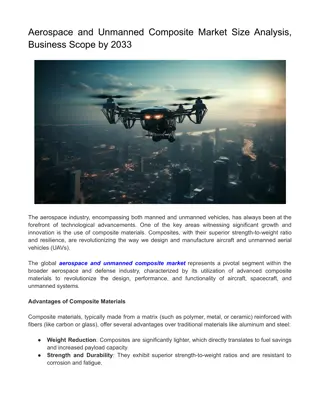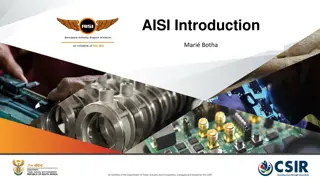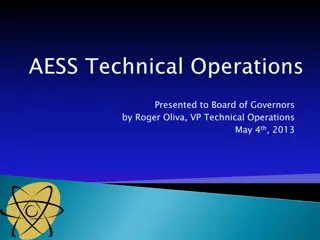Manitoba Aerospace Collaboration Workshop
Aerospace industry competitiveness relies on technology, collaboration, and strategic investments. This workshop series aims to foster collaboration in Manitoba to propel technological advancements and economic growth, emphasizing the benefits, risks, costs, and shared opportunities of partnerships.
Download Presentation

Please find below an Image/Link to download the presentation.
The content on the website is provided AS IS for your information and personal use only. It may not be sold, licensed, or shared on other websites without obtaining consent from the author.If you encounter any issues during the download, it is possible that the publisher has removed the file from their server.
You are allowed to download the files provided on this website for personal or commercial use, subject to the condition that they are used lawfully. All files are the property of their respective owners.
The content on the website is provided AS IS for your information and personal use only. It may not be sold, licensed, or shared on other websites without obtaining consent from the author.
E N D
Presentation Transcript
Manitoba Aerospace Collaboration Workshop David Simpson, EnviroTREC Gene Manchur, CIC
The Issue: Competitiveness Aerospace is a global industry with resources and economic success gravitating to those who provide the best technology and product at the most competitive price Technology, and the infrastructure to develop, use and capitalize on technology, are the basis of long term economic development Collaboration key to levering technology investments 2
Opening Remarks One a series of 3 workshops related to collaboration CARIC Workshop organized by the MAA Collaboration Workshop organized by EnviroTREC Collaboration Case Studies organized by MAHRC Other workshops on dedicated subjects may follow Objective of these workshops Foster collaborative activities in Manitoba through better understanding of the opportunities, processes and benefits Advance Technology Road Map technologies
Benefits of Collaboration Why collaborate? Access to technology to advance business goals Access to facilities Access to Subject Matter Experts Access to funding Relationship building/market access Cost sharing Accelerate developmental schedule ............
RISK, COST, BENEFIT Appropriate sharing of Risks, Costs and Benefits is the basis of successful collaborations: If one partner has a disproportionate share of any one of these parameters, collaborative partnership difficult to manage or in fact, establish Each partner must evaluate these parameters from their perspective to ensure the risks and costs they carry are commiserate with the benefits they expect to accrue
RISKS? Not achieving technical goal (self or partners) Underestimate of time allocation Loss of a critical resource person/facility External event changing priorities (self or partners)/Partner withdrawal Goal becomes less valuable Schedule slippage, cost increases
COST Usual Shared Costs included in estimating the cost of a project include personnel time, facility access time, technology licences, consumables, contracts to third parties, travel, overhead Looking at internal costs, Partners need to also consider secondary items such as lost revenue earning productivity, overtime . Robust project management imperative to monitor progress and control resources
Partners for collaboration What are your Company s future products and services in: 5 years? 10 years? What technologies, skills, capabilities will these require? What are your gaps?
Partners for collaboration Company needs and goals future products and services Technology and business interests Depth of collaboration, Technology Readiness Levels Academic research, TRL 0-3 Pre-competitive, TRL 4-6 Competitive, TRL 7+ Expected outcomes Knowledge Products and services
Partners for collaboration Width of network and partnership Local Regional National Global
Partners for collaboration Mechanisms to identify potential partners Special Interest Groups Research entities Government agencies Trade Shows Symposiums Associations Literature
Partners for collaboration Considerations Establishing your network Sharing a network Leveraging suppliers and customers Collaborating with competitors advantages disadvantages Time requirements Commitments, cash and in-kind
Mechanics of Partnership Collaborative agreement needed to cover all aspects of the project no gaps or assumptions Defines the business arrangement to co- develop and exploit intellectual property Develop new technologies Combine existing technologies Exploitation/innovation the key Built on Intellectual Property sharing
Intellectual Property Partners need formal access to both background and foreground technologies for exploitation Background Technologies If fundamental to exploit foreground technology, one partner must grant access to other partners for specific usage, NDA s common (can be valued during cost sharing negotiations) Foreground Technologies Default is that both parties will own foreground Difficult to build business on co-owned technology IP agreements can modify this Field of application Geographic area Confidentiality, Sharing and Publication limits
Licencing Agreements/Ownership Many potential collaborations collapse under the weight of the legalities of IP IP agreement negotiations frequently built around unrealistic hypotheses related to exploitation Fundamental: Ownership of technology is not the issue, access and use is the issue Important to agree on method of protecting arising technology: patent ($), non-disclosure agreements, restricted access, know-how
COST SHARING ARRANGEMENTS Common to have a variety of partner organizations: industry, academia, funding agencies, government (including labs) All will have policies directing how projects are costed e.g. overhead, capital depreciation, hourly cost structures, equipment usage . External funding agencies have policies directing what can be included in grants applications as well as staking limits
COST SHARING ARRANGEMENTS Accounting issues add to complications but unlike IP, are rarely a determining factor: The partners and the funding agencies want a good project to proceed Important for partners to understand the basis of cost estimation at an early stage Templates assist in organizing and detailing costs by providing direction and organization
Collaboration Agreement Management Structure of team Roles, Responsibilities and Authority Goals and deliverables Clarity of purpose Leadership Champions Technical and/or Managerial
Collaboration Agreement Management Project Management role Responsibility and authority Budget control Schedules Review cycles Change management and control Termination
Collaboration Agreement Management Team member locations Co-located teams Virtual teams Hybrid teams Information access and sharing Contractual vs collaborative Meetings and workshops The importance of face-to-face
Collaboration Agreement Management What are some of the key best practices to managing a successful collaboration? What have you seen go right, and go wrong?
FUNDING and SUPPORT Collaboration key to levering technology investments Collaboration: two or more partners working towards a common goal Partners can be industrial, academic, funding, government, private investors Best business practice: Lever your innovation investments through collaboration
FUNDING and SUPPORT Significant funding is available to assist industry in their pursuit of innovation WD, CARIC, NSERC, IRAP, CRIAQ, CFI, ISTPP, WINN, SDTC, OERD, DRDC, MITACS, BDC, TDP, SADI .. General characteristics: Terms and conditions focussed on a specific goal All come with overhead from application process through reporting and perhaps repayment phases All seeking good projects
FUNDING and SUPPORT Industrial Partners Self fund their participation, you gain access to results Academia Frequently do not seek cost recovery of their labour, provide low cost access to facilities, can access external funds not available to industry Academic schedule, IP protection (grad students) Government Research Laboratories Major facilities, potential for collaboration, international linkages, rarely provide funding
The Challenge: FUNDING and SUPPORT Balance compromises Scope of Activity Influenced by Partner goals Control of Schedule Influenced by Partner priorities Control Intellectual Property Influenced by Partner collaboration agreements Overhead Influenced by Partner requirements (funding agencies)
Collaboration Case Studies March 3, 2015 Time Lead Topic 0800 Wendell Wiebe - Host (5 minutes) Introductions and Opening Remarks 0805 David Simpson Moderator (10 minutes) B/E Aerospace and FastAir (30 minutes) David Simpson (15 minutes) B/E Aerospace, CIC, Cormer, Boeing (30 minutes) Summary of Session # 2 Feb 10, 2015 0815 Case Study # 1 B/E Aerospace and FastAir 0845 Q and A (Town Hall) 0900 Case Study # 2 CIC, Cormer, B/E Aerospace, Boeing 0930 David Simpson (15 minutes) David Simpson (10 minutes) Wendell Wiebe (5 minutes) Q and A (Town Hall) 0945 Conclusions / Next Steps 0955 Thanks to Attendees / Presenters / Partners & Sponsors, followed by Adjournment


